- Преподавателю
- Иностранные языки
- Открытый урок по английскому языку на тему: THE KAZAKH TRADITIONAL COSTUMES
Открытый урок по английскому языку на тему: THE KAZAKH TRADITIONAL COSTUMES
| Раздел | Иностранные языки |
| Класс | 11 класс |
| Тип | Рабочие программы |
| Автор | Кулметов А.П. |
| Дата | 16.10.2015 |
| Формат | docx |
| Изображения | Есть |
THE KAZAKH TRADITIONAL COSTUMES
The aims of the lesson.
-
To enrich the pupils' knowledge giving them more
information about the Kazakh traditional costumes. -
To develop the pupils' speech habits speaking on the
text and revising the grammar, helping them express freely
their thoughts and opinions. -
To bring up pupils to be patriots of their Motherland, to
love, know the Kazakh traditional costumes.
The type of the lesson: mixed.
The methods: complex work, question-answer, individual work.
The visual aids and equipment: pictures, cards, a tape recorder, the interactive board.
The connection with other subjects: Kazakh, Russian. Art, Biology.
The procedure of the lesson.
I. Organization moment. Talking with a pupil on duty, about date, day, season and marking absentees.
II. Checking the home task: customs and traditions.
III. Introduction of the new material: " The Kazakh traditional costumes".
T: The theme of the lesson is 'The Kazakh traditional costumes'.
The Kazakh traditional costumes are actually the dresses of an ancient nomad. Many kinds of European clothes also originated here in Central Asian steppe. Europeans deeply impressed when they first saw the nomad's clothing. Trousers are the invention of nomads which were used for riding. Such words as 'camisole' and 'caftan' were borrowed from the languages of Turkic nomadic tribes. The Kazakh traditional costumes are kimeshek, shapan, camizole, kebis. takhia, tymak.
Shapan. The shapan is man's outer robe made of velvet, velveteen or velour. It is worn with a belt and its bottom and flaps are decorated with a pattern made of braid in traditional style. Usually the shapan is presented to a noble and honored quest as a sign of one's special favour and attention.
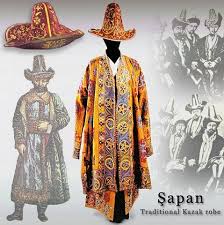
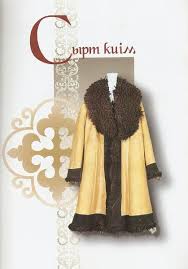
Camisole. The camisole is an overcoat both for men and women put over a shirt or dress. It is usually sleeveless, ending at the hips or waist and closed with special fasteners. Women's camisoles are more brightly colored than men's.
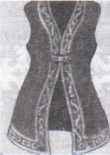
Kimeshek. For a married Kazakh woman to uncover her hair was considered indecent. Often she covered it with a head-dress with a turban arranged as a cylinder on the head and a shawl which had a special cut for her face.
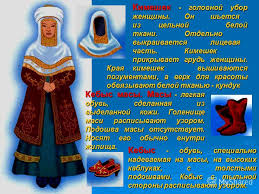
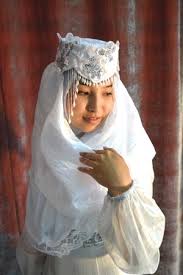
Takhia. The takhia is a men's everyday cap which covers the top and back of the head. Different forms are worn by the different people groups of Central Asia.
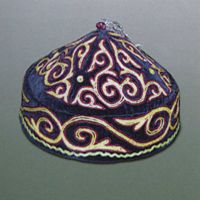
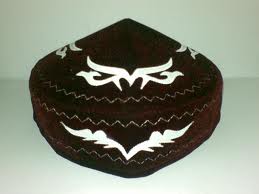
Tymak. The tymak is a traditional men's head-wear consisting of two flaps protecting the ears and a third part covering the" back of the head and neck down to the shoulder-blades. It is made from animals fur. The upper part is usually decorated with cloth.
IV. New words:
Camisole - қамзол Shapan - шапан
Kimeshek - кимешек Takhia - тақия
Tymak - тымақ Sew - тігу
Braid - көмкеретін жіп Velour - велюр
Velvet - барқыт, вельвет
V. Do the wordsearch and see if you can find words about the Kazakh
traditional costumes.
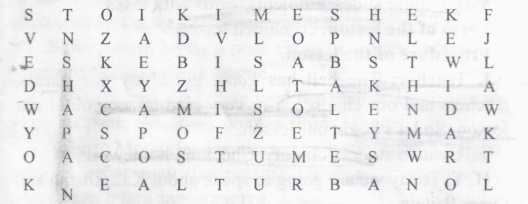
VI. How do you say these words in Kazakh, in Russian, and in English?
In English
In Kazakh
In Russian
костюм
traditional
одежда
кимешек
вельвет
over coat
велюр
takhia
камзол
VI. Comprehension check.
-
The Kazakh traditional costume is actually the dress of on ancient nomad.
-
The shapan is presented to a noble and honored quest as a sign of one's
special favour and attention. -
The takhia is not men's everyday cap which covers the top and back of the
head. -
The tymak is not traditional men's head wear.
-
The tymak is made from animals fur.
VIII. Home task.
English language teacher:…………………Usmanova Sayora.


